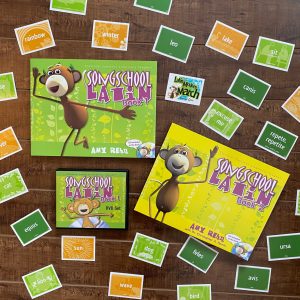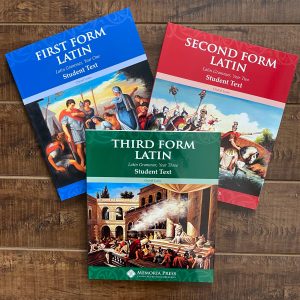A Path for Learning Latin

First, I gave up learning Latin!
Once upon a time, long ago, I wanted to learn Latin. I was not necessarily convinced by all the discussions and articles that went on at length about the benefits of Latin. I was a teenager, and Latin was “dead” they said. So I wanted to know more.
After trying out a few courses, including Wheelocks Latin, I gave up. I did not understand why the endings of the words kept changing. I did not get how they did that thing with action verbs and being verbs. And let us not even start talking about prepositions. Back then Latin tutors weren’t even thinking about tutoring yet. Self-included.
Latin from a Grammar vs. Vocabulary Emphasis
Fast forward a few years, and a couple of babies. Of course, you must decide on which curriculum to use before your child turns 2, so I was on it. I was reviewing and reading up on anything and everything that might prepare me and my children for their education. This time around, there was more discussion around the learning of Latin. I had given up hope for myself, but I was convinced that Latin was necessary for a well-rounded education for the sake of my children. But this time I decided to go a different route. Rather than learning Latin from a vocabulary emphasis, I decided to learn it from a grammar emphasis.
What is the difference? Well, with a vocabulary emphasis the goal is to have the student reading and speaking Latin as soon as possible. The more you read, the more you understand which endings go along with each other, and the more words you memorize the broader your vocabulary so you can start to understand what you are reading.
With a grammar emphasis, the rules of Latin are taught, alongside vocabulary to be sure. But there are a few key reasons why one might want to learn Latin from a grammatical perspective if one is already fluent in English.
- Latin grammar and English grammar are very similar so as one learns Latin grammar it can double up as English grammar. What we take for granted as “the way it is” in English will be explained as a logical and reasonable structure for communication.
- Latin has 4 conjunctions and 5 declensions. That is all. (Ok sure, there are a few more things you need to know, but once you get the pattern and basic structure of conjugating and declining, everything else will fit around your basic knowledge of Latin.) Once those are learned, it is just a matter of using those endings and pairing them with the vocabulary to create grammatically correct sentences. There is not as much “guess” work. You have the pieces, you know how they fit together, now you just need practice.
- The Latin language has gender forms. By learning which gender a declension signifies, it is easy to tell the gender of vocabulary without memorizing that little bit of important information and all the vocabulary. Does it end with -a, -ae? It is feminine; -us, -i? Masculine.
- By learning how to put the grammar rules together, I have also learned how to parse English, and English grammar has become one of my favorite subjects. Words matter. We need to know how to construct a sentence with accuracy and precision.
- Many English words come from Latin. As Latin vocabulary knowledge expands, so will your understanding of the English language.
There are great minds who have written extensively on the benefits of Latin. I would encourage you to read a few of their thoughts. And if in doubt, just jump into teaching Latin in faith. The riches are there, and some of them cannot be explained; you have to experience them. Here is the plan that I have pursued.
A Plan for Teaching Latin
Latin Resources for Ages 4-6

After I’ve said all that, I’ll be honest and admit that yes, this is a vocabulary program and it’s an excellent way to start with a young child. It introduces them to the language and gives them a few words to use around the house. This is especially fun if you have older kids learning Latin. Anything that makes the younger ones feel a part of the family is a winner. The DVD is the best part of this course. If you have a child who loves workbooks, add that in. But if your child isn’t into that, then just do the DVD.
Latin Resources for Ages 7-8

- This is a simple program that teaches a list of vocabulary words, a Latin saying, and a grammar form each week for 25 weeks, with 5 review lessons. If this is your first time teaching Latin, then I recommend the DVD or Online Streaming videos.
- The flashcards are a helpful, simple way to review the weekly memory work.
- Age 7 can do this work, but do not add on the extras.
- Age 8 can do this for a second year and add in the extras, or start here.
Add ons:
Ludere Latin
Latin Review Worksheets (year 2)
Ecce Caecilia Et Verus (Latin Reader).
Note: if you are someone who really needs to learn from a vocabulary perspective, then you would love Song School Latin, Book 2 followed by Latin for Children, Primer A instead of the above.
Latin Resources for Ages 9-12
First Form Latin, Second Form Latin, Third Form Latin

- This program can also be an entry point for a student. If you are just starting your Latin lessons at these ages, start with First Form Latin.
- This is a slow, methodical walk through Latin grammar forms while presenting vocabulary to memorize. The Student Workbooks presents repetitive work for mastery.
- The DVDs or Online Streaming are necessary if you have not learned Latin before.
Add ons:
Ecce Caecilia Et Verus (Latin Readers)
Lingua Angelica
Acts of the Apostles: A Latin Reader
Lingua Latina Series
Note: if you are someone who really needs to learn from a vocabulary perspective, then you would love Latin for Children, Primer A, Primer B, and Primer C instead of the above.
Latin Resources for Ages 12+
Fourth Form Latin and Henle Latin

- With some study of Latin, a student can start here. This reviews First – Third Latin: all the forms and vocabulary.
- By adding in the First Year of Henle Latin, this program will launch the student on to 4 more years of study using the Henle program.
Note: If you really need to learn from a vocabulary perspective, you would love the Latin Alive Program instead of the above.
by Hester VanBraeden
Hester is a second-generation home-educating parent who is keenly aware that her own education is not complete, and comfortable that it probably never will be. She has many years of experience with children, books, and curriculum and loves to travel to worlds and times beyond the present with her four children through stories.
